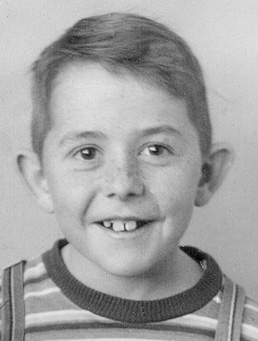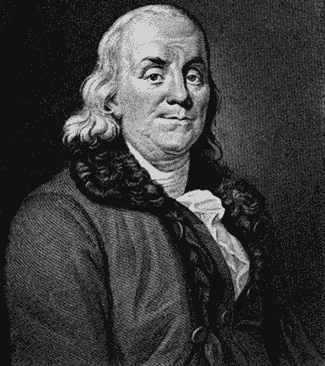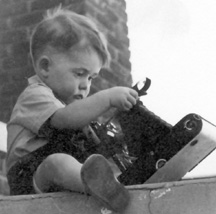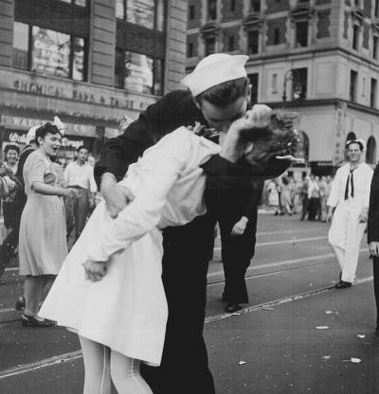School Days
I enjoyed
school for the most part, even though I had troubles paying attention
and
sometimes got distracted enough to blow off a whole work session. My
first day
in first grade was a disaster for me. I was supposed to divide a circle
into
halves and quarters and color parts of them and time was up and I had
nothing
to show. How humiliating! My first day and I blew it. It was the end of
the
world for me.
 I
went to
David Crockett Elementary School, named after a famous Texan, who I
found out
later was from Tennessee; and he was just unfortunate enough to be
killed in
Texas by a whole lot of Mexicans. Later on in life, I discovered that I
was
surrounded by Mexicans. In Texas, most of the schools were named after
men who
died in the Alamo. Most El Paso schoolchildren could rattle off the
names of a
dozen martyrs who had given their life for the Republic. All they had
to do was
close their eyes and name all the schools in town.
I
went to
David Crockett Elementary School, named after a famous Texan, who I
found out
later was from Tennessee; and he was just unfortunate enough to be
killed in
Texas by a whole lot of Mexicans. Later on in life, I discovered that I
was
surrounded by Mexicans. In Texas, most of the schools were named after
men who
died in the Alamo. Most El Paso schoolchildren could rattle off the
names of a
dozen martyrs who had given their life for the Republic. All they had
to do was
close their eyes and name all the schools in town.
I had
crushes on pretty little girls from the very beginning. I had to learn
about
the pecking order of who is worthy (meaning me) and who is unworthy (me
again).
I really felt sorry for the girls that looked like they would grow up
to look
like Eleanor Roosevelt. There was one such girl in my class. Her father
was the
fire chief and I thought he was really great because he treated me very
well
when we toured the fire station. She was quite gangly and awkward and
couldn’t
keep the hem of her dress down to save her. One day, I accidentally got
flashed
by her private parts as she was squirming in class and it grossed me
out. I
stopped seeking those experiences for quite a while after that.
I always
wondered what happened to Sandra Kay O’Connell. She was so pretty,
petite, and
smart. I was mostly speechless in her presence. One day, the teacher
announced
that she had moved away. Forty years later when Sandra Day O’Connor
became a
Supreme Court Justice, I got excited about the pretty, blonde judge and
tried
to make a connection between the two. The age was right; the location
was
close; but no connection, just similar sounding names.
I consider
myself fortunate to have known Mary Mahoney in grade school. She was
very
attractive with large, dark, wide-set eyes, and a great head of dark
hair. We
sometimes walked part-way home together after school. I could tell her
special
things like when my mother was pregnant and when it turned out to be a
boy. She
was my first date. We went to a downtown movie; which was a big deal,
because
we had to use public transportation and neither one of us had ever made
the
trip before. Money was a problem and I budgeted very carefully but I
just had
to splurge on a Hershey bar for her and wound up having to borrow 15
cents from
her so we could get home. She was really nice about it and we were good
friends
until one day her father reminded her I was not Catholic. I had a good
eye for
beauty. The most beautiful woman in the world to me was Jane Russell
who
appeared in The Outlaw. I had seen published pictures of her in the paper and
on the cover of Life magazine. I thought Mary might grow up to look like Jane
Russell. Can you imagine a third grader who looks like Jane Russell?
When I was
in the fifth grade I took a little piece of copper pipe to school and a
pocket
full of barley. Pea shooters were very popular at the time but I found
them too
large and inconvenient and so I combined the smaller, shorter copper
pipe with
a smaller projectile and I had a stealth weapon that could easily be
concealed.
I even shot barley in the classroom when the teacher turned her back. I
was
getting away with it for a while and then it was time for math. We were
studying fractions and had just been introduced to the concept that
division
was just like multiplication except you had to invert the divisor
before
multiplying. The teacher suggested we demonstrate the principle in a
way we all
would not forget. I was nominated to become the divisor. Two of the
larger boys
would perform the inversion operation. I had forgotten that I had a
cache of
barley in the bib pocket of my overalls, but I remembered as soon as my
feet
were in the air. The teacher was absolutely right. I never forgot how
to divide
by a fraction for the rest of my life. I was never quite sure whether
that was
an accident or whether I was set up, so to speak.
Once I
learned to read, I became a voracious reader. One summer, I read 100
books.
After making that trip downtown with Mary Mahoney, I could navigate to
the
library and back and my mother thought it was worth underwriting the
bus fare
if it would help educate me. There were about 40 Hardy Boys books and I managed to find most of
them. There was one other book that simply amazed me. It was like a
dictionary
of inventions and mechanisms published by Popular
Mechanics magazine. It was the key to how things
worked. I read it from cover to cover and went back many times for a
refresher.
I was given
as a gift an autobiography of Chief Sitting Bull called My Indian
Boyhood.
Since it was mine, I could read it over and over. It left very vivid
pictures
in my mind.
 The other
favorite was The
Autobiography of Ben Franklin, written for
children. In writing my
own memoir, I pulled Franklin’s original text and margin notes from the
internet and decided the original document was far too deep for me to
have
read, even though he did write it specifically for youth on advice from
some of
his French friends. What I read as a child had obviously been dumbed
down to my
level. He was my first historical hero.
The other
favorite was The
Autobiography of Ben Franklin, written for
children. In writing my
own memoir, I pulled Franklin’s original text and margin notes from the
internet and decided the original document was far too deep for me to
have
read, even though he did write it specifically for youth on advice from
some of
his French friends. What I read as a child had obviously been dumbed
down to my
level. He was my first historical hero.
Franklin
started setting his course when he was very young. He was apprenticed
to a
printer and immediately recognized the power of the press when he wrote
articles which he signed ‘Silence Dogood’ and slipped under the
newspaper
publisher’s door when he was 16 years old. Later, he created Poor
Richard’s Almanac; which he authored for 25 years
and influenced the psyche of the American
people. Circulation was about 10,000 copies. He was a scientist and an
inventor. He invented bifocal eyeglasses, designed musical instruments,
and
discovered many electrical properties. He eliminated the fear of
thunder and
saved the lives of thousands of church bell ringers by inventing
lightning
rods. Up until that time it was thought that lightning was God’s wrath.
He went
to France and became the representative of the new America. He was very
popular
there and then he returned home just in time to participate in the
Declaration
of Independence and our great constitution.
I wanted to
do things like that. So I asked my parents for a printing press and for
Christmas it came. It was a toy with rubber type. I could shove the
type into
the slots on the roller and crank out multiple copies. It took me a
while to
figure out the backwards characters but I was prepared by Ben’s
description of
minding the p’s and q’s. There were other duplicating devices such as
dittos,
carbons, hectographs, and mimeo stencils. Before long, I was an expert
at
printing. Eventually I too, would serve a printer’s apprenticeship.
In honor of
my hero Ben Franklin, I punctuate new thoughts with some of his famous
sayings.
“Being
ignorant is not so much a shame as being unwilling to learn.”
– Ben Franklin
 I remember
that my father took pictures and developed them himself. He had several
bellows
type cameras that used large film formats and his pictures were always
sharp
and clear. He taught me about lenses, f-stops, and timers. This also
became
ingrained in my thought processes and when I had a chance to do my own,
it came
easy. My dad taught me how to make crystal radio sets and another man
in the
neighborhood bought a transistor and upgraded the crystal set. I don’t
remember
who the man was; but he was on the bleeding edge of technology. The
transistor
was invented in 1947; and this man, living in a converted chicken coop,
sleeping on an army bunk, had a transistor in a circuit mere months
after it
was invented. It must have cost him a flat fortune because years later
when
they became available to the public they were around $40 each. It would
be
another ten years before transistor radios would be available to the
public.
Who was that man anyway? Years later, my interest in electronics would
serve me
well.
I remember
that my father took pictures and developed them himself. He had several
bellows
type cameras that used large film formats and his pictures were always
sharp
and clear. He taught me about lenses, f-stops, and timers. This also
became
ingrained in my thought processes and when I had a chance to do my own,
it came
easy. My dad taught me how to make crystal radio sets and another man
in the
neighborhood bought a transistor and upgraded the crystal set. I don’t
remember
who the man was; but he was on the bleeding edge of technology. The
transistor
was invented in 1947; and this man, living in a converted chicken coop,
sleeping on an army bunk, had a transistor in a circuit mere months
after it
was invented. It must have cost him a flat fortune because years later
when
they became available to the public they were around $40 each. It would
be
another ten years before transistor radios would be available to the
public.
Who was that man anyway? Years later, my interest in electronics would
serve me
well.
 One day
Harry Blackstone, the magician, came to town; and they had matinee
performances
for school kids. Mom came up with the admission cost; which covered the
streetcar fare; and the school put us on special streetcars going to
Masonic
Auditorium in El Paso. I had a very good seat in about the fourth row
and got
to see the famous floating light bulb trick and Blackstone cut his
daughter in
two with a giant lumber saw and no box. From that moment on I was sure
I would
like to become a magician.
One day
Harry Blackstone, the magician, came to town; and they had matinee
performances
for school kids. Mom came up with the admission cost; which covered the
streetcar fare; and the school put us on special streetcars going to
Masonic
Auditorium in El Paso. I had a very good seat in about the fourth row
and got
to see the famous floating light bulb trick and Blackstone cut his
daughter in
two with a giant lumber saw and no box. From that moment on I was sure
I would
like to become a magician.
 Later on my father
took me to see the Great Oznola
(Alonzo spelled backwards). He introduced me to him because he, like my
father,
was a railroad mechanic. My father impressed upon me the fact that
there were
more magicians than there were jobs for magicians and that I ought to
have a
day job as well.
Later on my father
took me to see the Great Oznola
(Alonzo spelled backwards). He introduced me to him because he, like my
father,
was a railroad mechanic. My father impressed upon me the fact that
there were
more magicians than there were jobs for magicians and that I ought to
have a
day job as well.
I remember
the end of World War 2. The Germans were defeated in May of 1945 but
the
Japanese kept on fighting and then we dropped the bomb; twice. We had
been
close to the site where the first atom bomb had been tested. It was
only about
65 miles away near Alamogordo, New Mexico. They called it V-E Day
(Victory in
Europe) when the Germans were defeated. It was called V-J Day (Victory
in
Japan) when the Japanese surrendered. School was out and it was a hot
summer
day in El Paso. The buzz went around the neighborhood and someone said
something about celebration. I was nine years old and was badly in need
of
something to celebrate. So I took myself down to the drugstore about
four
blocks from my house and ordered something I always wanted, a cherry
sundae
made with crushed maraschino cherries, whipped cream, and a cherry on
top. It
was an old fashioned soda fountain in a corner drug store. The fountain
was
shaped like a long island instead of against the wall. It had several
jerk
stations with a pair of spritzer faucets at each one. You could look
across the
fountain and see the people on the other side. I don’t think there was
anyone
else at the fountain that day except the soda jerk, so I explained to
him that
I was celebrating because it was V-J Day. It was a very delicious
sundae. I ate
it slowly and marveled at how sweet and flavorful minced maraschino
cherries
could be; and I vowed to order it again instead of the syrup sundae.
When I
went to pay for it at the front counter with my 15 cents, I discovered
why it
was so good. It cost more than 15 cents. After explaining to the
cashier about
my plight he reckoned he could help me celebrate and covered my check.
I
offered to get the rest of the money later and he told me to forget it.
He was
celebrating too. That was my first experience with redemption. Someone
else
paid and got me off the hook. I walked on the opposite side of the
street on
the way home because there was a bar there, the only one I knew of, and
certainly there must be someone celebrating there. I walked by and it
smelled
like beer and urine so I assumed someone was in there. I didn’t turn my
head to
look in; just kept walking, so I am not sure whether I celebrated alone
in El
Paso or maybe there were other people in another neighborhood whooping
it up.
 Later
I saw, on a Life magazine cover, a sailor kissing a girl in the middle
of the street in New York City. I begin to form the idea that I lived
in a
really boring place.
Later
I saw, on a Life magazine cover, a sailor kissing a girl in the middle
of the street in New York City. I begin to form the idea that I lived
in a
really boring place.
We had
become very paranoid with the ideas that Germans might get loose on the
streets
of El Paso. There were a lot of POWs being kept at Fort Bliss and they
sometimes were used to do clean up jobs around the residential
neighborhoods.
We always were on the lookout for escapees. And then they showed up at
school,
not POWs, but the kids of the 116 rocket scientists that came over with
Werner
Von Braun! We were traumatized. These were not little kids like us.
They were
big kids that were being mainstreamed in at a lower grade until they
could pick
up the language. They would jump up and click their heels when called
on in
class, and spoke with great authority. They dressed very sharply and
made us
look like slobs. I could tell they were very bright. They were children
of the
men that developed the V2 rocket and buzz bombs. I had read about these
things
in my spotter manuals. These guys scared me! The girls had grown up
bodies with
breasts and I, being very short, was at eye level with those breasts.
Any of
the guys could have punched us out in short order. I avoided them as
much as I
could. They pretty much liked to stick together anyway. I didn’t blame
them for
that.
Then, one
day at about 11 AM, there was a boom that shook the earth. Were they
testing
another atom bomb in Alamogordo? No, it sounded like it came from the
south.
Maybe it was a natural gas storage tank. I checked from the top of my
grape
arbor in the back yard. No, the tank seemed to be intact. There was
only one
source of information, the radio in the house. The noise came from the
edge of
Juarez, the town across the border from El Paso. There was some
activity from
Alamogordo. Someone had seen a vapor trail go up just prior to the
boom. The
German scientists had bombed Mexico with a V2 rocket they had shipped
from
Germany! It was claimed to be an accident. It had no warhead, sure.
People
around El Paso were not so sure they wanted to have their old arch
enemy
playing with weapons of mass destruction so close to town. I don’t
remember
seeing the German kids after that. The year after I graduated high
school, the
Germans moved to Huntsville, Alabama to build the rockets that allowed
men to
go into space and walk on the moon. In 1955, Werner Von Braun became an
American citizen.
I don’t
know what finally precipitated it; but my folks decided it was time to
move at
the end of sixth grade (1947) at Crockett Elementary School. Maybe it
was
because all four of us boys were sleeping in the same tiny converted
sleeping
porch. I went back to that house fifty years later and couldn’t believe
how it
had shrunk. The original kitchen stove and sink were still there and I
had to
side step through it to keep from bumping things. What I had remembered
as a
draining board next to the sink was a fold down pantry door in a
cabinet. Maybe
my mother was putting on weight and could no longer navigate that
kitchen.
I did mark
this time in my life by my first wet dream. I was so confused I almost
fell out
of the top bunk. Life was changing, maybe for the better.


